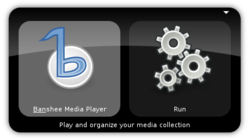| GNOME Do | |
|---|---|
 | |
 GNOME Do in action (Classic interface shown) | |
| Original author | David Siegel |
| Stable release | 0.95.3 (November 12, 2014) [±] |
| Repository | |
| Written in | C# |
| Operating system | Linux |
| Platform | GNOME, Mono |
| Type | |
| License | GNU GPL |
| Website | do |
GNOME Do (often referred to as Do) is a free and open-source application launcher for Linux originally created by David Siegel, [1] and currently maintained by Alex Launi. Like other application launchers, it allows searching for applications and files, but it also allows specifying actions to perform on search results. GNOME Do allows for quick finding of miscellaneous artifacts of GNOME environment (applications, Evolution and Pidgin contacts, Firefox bookmarks, Rhythmbox artists and albums, and so on) and execute the basic actions on them (launch, open, email, chat, play, etc.). [2]
Contents
While it is designed primarily for the GNOME desktop, it works in other desktop environments, such as KDE.
GNOME Do was inspired by Quicksilver for Mac OS X, and GNOME Launch Box. [3]
